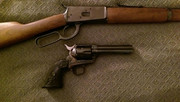I have a 1906 vintage Model 1894 Winchester rifle, caliber .32-40, in well-worn condition and not as accurate as I would like. I could keep my shots on a paper plate at 100 yards, but it would not shoot a tight group. The rifle was also difficult to clean after a shooting session because it tended to lead up from the cast bullets I use. The bore had worn rifling, and pitting was also very evident. A bore scope showed the pitting was far worse than I had thought. I had two options if I wanted to make this rifle shoot- have it bored out to .38-55, or get a .32-40 caliber liner put in it. I already have a .38-55, so I decided to get the liner. Before I could get it done, the 2018 Carr Fire destroyed my home and all my reloading equipment, but I did save most of my gun collection, including the .32-40. It has languished in my gun safe since the fire. As I have slowly rebuilt my reloading supplies and equipment, it came time to do something about the .32-40.
I sent the rifle to John Taylor in Puyallup, Washington as he has a good reputation for installing liners. It took a little over three months and a little over $500, but he did an outstanding job and now my rifle has a new bore. I don’t know how he did it, but the liner is invisible at the muzzle.


While waiting for the rifle’s return, I bought a set of RCBS Cowboy reloading dies and an RCBS 32-170-FN bullet mould. No brass was available, so I reformed a few hundred .38-55 brass to .32-40. By the time I got the rifle back I had a hundred rounds of various loads to test. I was delighted with the results of my 50 yard targets. The rifle shot very well with several different powders.
Seventeen grains of Reloder 7 gave just over 1,600 fps:

Fifteen grains of IMR 4198 gave just under 1,500 fps:

Fourteen grains of AA5744 gave 1,454 fps:

Now all I have to do is get some sight settings and go shoot some silhouette!

Shasta






